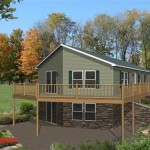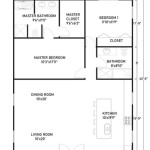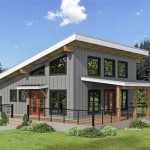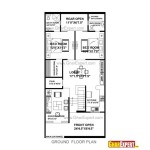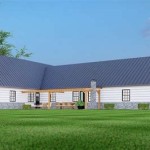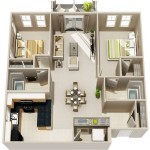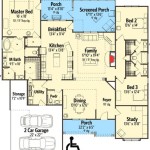House Plans Under 600 Sq Feet: Maximizing Space and Functionality
The surge in popularity of small house plans, particularly those under 600 square feet, reflects a growing interest in minimalist living, affordability, and sustainable design. These compact dwellings present unique challenges and opportunities for architects and homeowners alike. Crafting a functional and comfortable living space within such a limited footprint requires meticulous planning, innovative design solutions, and a keen understanding of spatial optimization. This article explores the key considerations and design principles involved in developing effective house plans for structures under 600 square feet.
Understanding the Appeal of Small House Living
Several factors contribute to the appeal of small house living. Firstly, the reduced construction and maintenance costs make homeownership more accessible to a wider range of individuals and families. The initial investment is significantly lower than that of a larger home, and ongoing expenses such as property taxes, utilities, and maintenance are also minimized. This financial advantage allows homeowners to allocate resources towards other pursuits, such as travel, education, or investments.
Secondly, small houses promote a more sustainable lifestyle. Their smaller footprint reduces the demand for resources during construction and minimizes energy consumption for heating, cooling, and lighting. This aligns with the growing environmental consciousness and the desire to reduce one's ecological impact. The compact nature of these homes also encourages a more mindful approach to consumption, as residents are forced to prioritize possessions and declutter their lives.
Thirdly, the simplicity and intentionality of small house living appeal to those seeking a more focused and less materialistic lifestyle. By embracing a smaller living space, individuals can free themselves from the burdens of maintaining a large home and accumulating unnecessary possessions. This allows them to focus on experiences, relationships, and personal growth.
Key Considerations in Designing House Plans Under 600 Sq Feet
Designing a house plan within a 600-square-foot constraint necessitates careful consideration of several key factors. Every square inch must be utilized effectively, and design choices must prioritize functionality, comfort, and visual appeal. Below are some critical elements to consider during the planning process.
Space Efficiency: The core principle of small house design is maximizing every available space. This involves incorporating multi-functional furniture, such as sofa beds, folding tables, and storage ottomans. Vertical space should be exploited through the use of shelving, lofts, and high ceilings. Built-in storage solutions, such as drawers under beds and cabinets integrated into walls, can significantly increase storage capacity without encroaching on living areas. Open floor plans are generally preferred, as they create a sense of spaciousness and allow for flexible use of the limited area. Separating spaces visually – with changes in flooring, half walls, room dividers, or furniture placement – can delineate zones, without the space-consuming barriers of full walls.
Natural Light and Ventilation: Adequate natural light and ventilation are essential for creating a comfortable and healthy living environment in a small house. Large windows and skylights can bring in ample natural light, making the space feel brighter and more open. Proper ventilation is crucial for preventing moisture buildup and ensuring air quality. Cross-ventilation, achieved by placing windows on opposite sides of the house, is particularly effective. The orientation of the house on the lot should also be considered to maximize sunlight exposure and minimize heat gain in warmer climates.
Material Selection: The choice of materials can significantly impact the overall feel and functionality of a small house. Lightweight materials, such as wood and drywall, are often preferred to minimize structural load and cost. Light colors and reflective surfaces can enhance the sense of spaciousness by reflecting light. Durable and low-maintenance materials are ideal, as they reduce the need for frequent repairs and replacements. Environmentally friendly materials, such as bamboo flooring and recycled content insulation, can contribute to a more sustainable design.
Codes and Regulations: Before embarking on the design process, it's crucial to familiarize oneself with local building codes and regulations. Minimum square footage requirements, setback regulations, and zoning ordinances can significantly impact the design and construction of a small house. Compliance with these regulations is essential for obtaining building permits and ensuring the safety and legality of the structure. It's also important to consider accessibility requirements, particularly if the house is intended for elderly or disabled occupants.
Design Strategies for Optimizing Space in Under 600 Sq Ft Homes
Beyond the fundamental considerations, several design strategies can effectively optimize space and enhance functionality in small house plans.
Vertical Living: Utilizing vertical space is paramount in designing compact homes. Lofts can be used for sleeping areas, storage, or even home offices, freeing up valuable floor space below. High ceilings create a sense of spaciousness and allow for the installation of tall shelves and cabinets. Built-in ladders and staircases can provide access to lofts while minimizing their footprint. Strategic placement of lighting is also crucial, with pendant lights and spotlights used to illuminate vertical spaces and create visual interest.
Multi-Functional Zones: Designing spaces that serve multiple purposes is essential for maximizing efficiency. A living room can double as a guest bedroom with the use of a sofa bed. A dining table can also function as a workspace. Kitchen islands can provide both storage and countertop space. By carefully considering the needs and habits of the occupants, designers can create flexible spaces that adapt to different activities.
Smart Storage Solutions: Innovative storage solutions are crucial for keeping small spaces organized and clutter-free. Built-in storage, such as drawers under beds, cabinets integrated into walls, and shelves hidden behind mirrors, maximize storage capacity without taking up extra floor space. Vertical storage, such as tall shelves and wall-mounted organizers, utilizes often-overlooked vertical areas. Modular storage systems allow for customization and adaptability as needs change. Prioritizing storage for frequently used items and minimizing clutter are key to maintaining a functional and comfortable living environment.
Outdoor Extensions: Extending the living space outdoors can significantly enhance the perceived size and functionality of a small house. Decks, patios, and balconies provide additional areas for relaxation, dining, and entertaining. Outdoor kitchens and gardening spaces can further expand the living space. Connecting the indoor and outdoor spaces through large windows and doors creates a seamless transition and blurs the boundaries between the interior and exterior. Careful landscaping can also enhance privacy and create a more inviting outdoor environment.
Efficient Kitchen Designs: Kitchens in small houses require particularly careful planning to maximize functionality within a limited space. Compact appliances, such as space-saving refrigerators and dishwashers, are essential. Vertical storage, such as tall cabinets and shelves, maximizes storage capacity. Multifunctional islands can provide both countertop space and storage. Open shelving can create a sense of spaciousness and allow for easy access to frequently used items. Careful consideration of the workflow and placement of appliances can improve efficiency and usability.
Bathroom Optimization: Bathrooms in small houses need to be designed with efficiency in mind. Wall-mounted toilets and sinks can save valuable floor space. Showers can be more space-efficient than bathtubs. Vertical storage, such as tall cabinets and shelves, maximizes storage capacity. Mirrors can create the illusion of more space. Proper ventilation is essential for preventing moisture buildup and ensuring air quality. Careful selection of fixtures and finishes can enhance the overall aesthetic and functionality of the bathroom.
Common Challenges and Solutions in Small House Design
Designing a house under 600 square feet presents several common challenges. Addressing these challenges effectively is crucial for creating a functional and comfortable living space.
Feeling of Confinement: One of the primary challenges is to avoid creating a feeling of confinement. This can be addressed by maximizing natural light, using light colors and reflective surfaces, and incorporating open floor plans. Vertical elements, such as high ceilings and tall windows, can also create a sense of spaciousness. Thoughtful use of mirrors can visually expand the space. Minimizing clutter and maximizing storage are also essential for creating a more open and airy feel.
Limited Storage Space: The lack of storage space is another significant challenge. This can be addressed by incorporating built-in storage solutions, using multi-functional furniture, and exploiting vertical space. Modular storage systems allow for customization and adaptability as needs change. Prioritizing storage for frequently used items and minimizing clutter are key to maximizing available space.
Privacy Concerns: Maintaining privacy in a small house can be challenging, particularly in open floor plans. This can be addressed by using room dividers, screens, and strategically placed furniture to create defined zones. Curtains and blinds can provide privacy at windows. Careful placement of bedrooms and bathrooms can also minimize noise and visual intrusion.
Accessibility Issues: Accessibility can be a concern, particularly for elderly or disabled occupants. This can be addressed by incorporating universal design principles, such as wider doorways, grab bars in bathrooms, and ramps instead of stairs. Single-level designs are generally more accessible than multi-level designs. Careful consideration of the layout and placement of fixtures and appliances can also improve accessibility.
In conclusion, designing effective house plans under 600 square feet requires careful planning, innovative design solutions, and a keen understanding of spatial optimization. By prioritizing space efficiency, natural light, and smart storage solutions, it is possible to create functional, comfortable, and aesthetically pleasing small homes that meet the needs of a variety of lifestyles.

20 New 600 Sq Ft House Plans 2 Bedroom Image

Cottage Plan 600 Square Feet 1 Bedroom Bathroom 348 00166

Tiny Home Plan Under 600 Square Feet 560019tcd Architectural Designs House Plans

600 Sqft House Plans 2 Bedroom 10x60 Houseplans 20x30 30x20

18 X 32 Small House Plans Under 600 Sq Ft

How Do Luxury Dream Home Designs Fit 600 Sq Foot House Plans

600 Sq Ft House Plan Mohankumar Construction Best Company

600 Square Foot Tiny House Plan 69688am Architectural Designs Plans

Small House Floor Plans Under 600 Sq Ft

2 Bhk House Plan In 600 Sq Ft Gharka Naksha Rjm Civil

